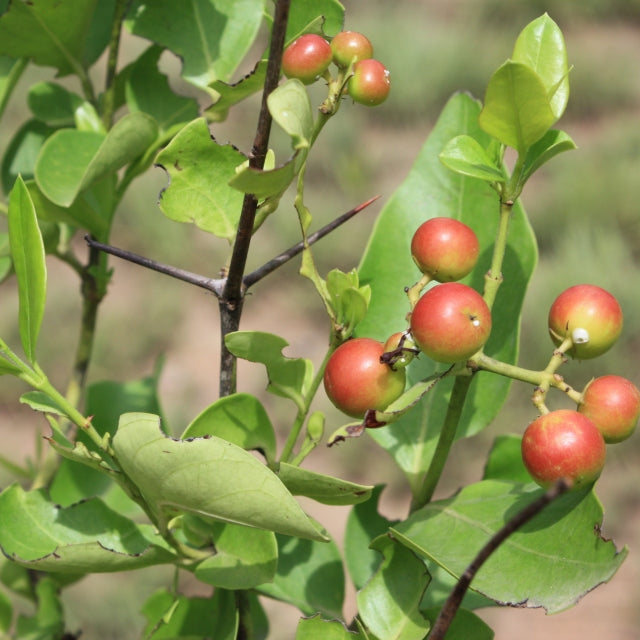Love it? Add to your wishlist
Your favorites, all in one place. Shop quickly and easily with the wishlist feature!
[message]
[title]
[message]


Veliyath Gardens
Couldn't load pickup availability
Description:
Climbing Num Num (Carissa spinarum), also known as Wild Num Num, is a hardy evergreen shrub producing sweet purple fruits with culinary and medicinal value. Discover its global significance, growth requirements, health benefits, and why it deserves a place in your garden.
Among the lesser-known yet highly valuable fruit-bearing plants, the Climbing Num Num (Carissa spinarum) stands out for its resilience, cultural importance, and nutritional fruits. Native to the drier parts of Africa, Asia, Arabia, Australia, and New Caledonia, this hardy shrub has been cherished across continents for its sweet, fleshy berries and medicinal uses.
Its combination of ornamental appeal, edible fruits, and traditional healing properties has made it a plant of both ecological and cultural value. With rising interest in rare and exotic fruit plants, the Climbing Num Num is steadily gaining popularity among home gardeners and collectors.
Botanical Name: Carissa spinarum
Common Names: Climbing Num Num, Wild Num Num, Carrisse, Conkerberry, Bush Plum, Garna (India), Karonda (South Asia), Amatungulu (South Africa), and Gunda (Australia).
Family: Apocynaceae
Growth Habit: Spiny, evergreen shrub or small tree, ranging between 1–5.5 meters in height.
Blooming/Fruiting: Begins producing fruits within 2–3 years.
Maintenance Level: Moderate, making it suitable for semi-experienced gardeners.
The Climbing Num Num thrives in dry tropical and subtropical climates.
Soil: Adaptable to sandy, rocky, and well-drained soils.
Light: Prefers full sun but tolerates partial shade.
Watering: Drought-tolerant once established but benefits from regular watering during fruiting season.
Temperature Range: Can withstand hot, arid conditions but also grows in mild, subtropical zones.
Pruning: Requires occasional pruning to manage shape and enhance fruiting.
Special Note: Its dense spiny branches make it an excellent natural hedge or barrier plant.
This plant’s adaptability has allowed it to spread naturally across Africa, South Asia, and even Australia, where it often grows wild in grasslands, scrublands, and open forests.
The Climbing Num Num fruit is highly prized for its unique flavor:
Appearance: Rounded, soft, fleshy berries turning dark purple to almost black when ripe.
Flavor: Sweet, slightly tangy, and pleasantly aromatic.
Texture: Juicy pulp with smooth consistency.
Consumption: Enjoyed fresh, or processed into jams, preserves, juices, and even fermented vinegar.
Its fruits are not only tasty but also rich in antioxidants and vitamins, making them a nourishing snack straight from the garden.
The fruits of Carissa spinarum are small but nutritional powerhouses.
Vitamin C: Boosts immunity and supports skin health.
Iron & Calcium: Helps in strengthening bones and improving blood health.
Antioxidants: Prevents oxidative stress, promoting heart and cellular health.
Dietary Fiber: Supports digestion and prevents constipation.
Immune Boosting: Regular consumption strengthens natural defense systems.
Energy Source: The fruit pulp provides quick natural sugars, making it a refreshing energy booster.
Bone Health: Calcium content supports teeth and bone strength.
Skin Benefits: Antioxidants and vitamins help improve skin glow and delay aging signs.
Across different cultures, the Climbing Num Num fruit has found a place in kitchens:
Fresh Eating: Sweet and fleshy, enjoyed as a fresh seasonal fruit.
Preserves: Commonly turned into jam, jelly, or chutney.
Fermented Beverages: Used for making vinegar or lightly alcoholic drinks in rural communities.
Desserts & Sauces: Blended into sauces, smoothies, or baked into pastries.
Local Delicacies: In Africa and Asia, the fruits are sometimes dried for storage and later rehydrated for use in traditional recipes.
Its versatile flavor profile makes it a favorite among both traditional households and modern kitchens experimenting with rare fruits.
The Climbing Num Num has been valued for centuries not just as food but also for its medicinal properties:
Roots and Bark: Used in traditional medicine as remedies for fever, stomach disorders, and respiratory problems.
Fruit Pulp: Consumed to improve digestion and vitality.
Leaves: Applied in poultices for skin ailments and minor wounds.
Tonic Uses: Indigenous communities in Africa and India prepared tonics from the plant as a strengthening and restorative remedy.
Its long-standing use in folk medicine underscores its importance in local healing traditions.
Dual Purpose: Both an ornamental shrub and a fruit-bearing plant.
Natural Fence: Dense, thorny branches act as a protective hedge.
Low Maintenance: Hardy and drought-resistant, suitable for challenging climates.
Exotic Appeal: Rarely available in nurseries, making it a unique addition to fruit gardens.
Sustainable Value: Supports biodiversity and offers fruit harvests for decades.
The Climbing Num Num (Carissa spinarum) is a plant of multiple virtues—from its sweet, purple fruits to its cultural, medicinal, and ecological significance. Hardy yet rewarding, it is ideal for gardeners seeking a plant that is both ornamental and functional.
At Veliyath Gardens, we are proud to introduce this rare, limited-availability exotic fruit plant to our valued customers. With its growing global demand and timeless traditional uses, the Climbing Num Num is not just a plant—it’s a living heritage of resilience, taste, and natural healing.
Light: Prefers full sun but tolerates partial shade.
Watering: Drought-tolerant once established but benefits from regular watering during fruiting season.
Temperature Range: Can withstand hot, arid conditions but also grows in mild, subtropical zones.
Vitamin C: Boosts immunity and supports skin health.
Iron & Calcium: Helps in strengthening bones and improving blood health.
Antioxidants: Prevents oxidative stress, promoting heart and cellular health.
Dietary Fiber: Supports digestion and prevents constipation.
Dual Purpose: Both an ornamental shrub and a fruit-bearing plant.
Natural Fence: Dense, thorny branches act as a protective hedge.
Low Maintenance: Hardy and drought-resistant, suitable for challenging climates.
Exotic Appeal: Rarely available in nurseries, making it a unique addition to fruit gardens.



